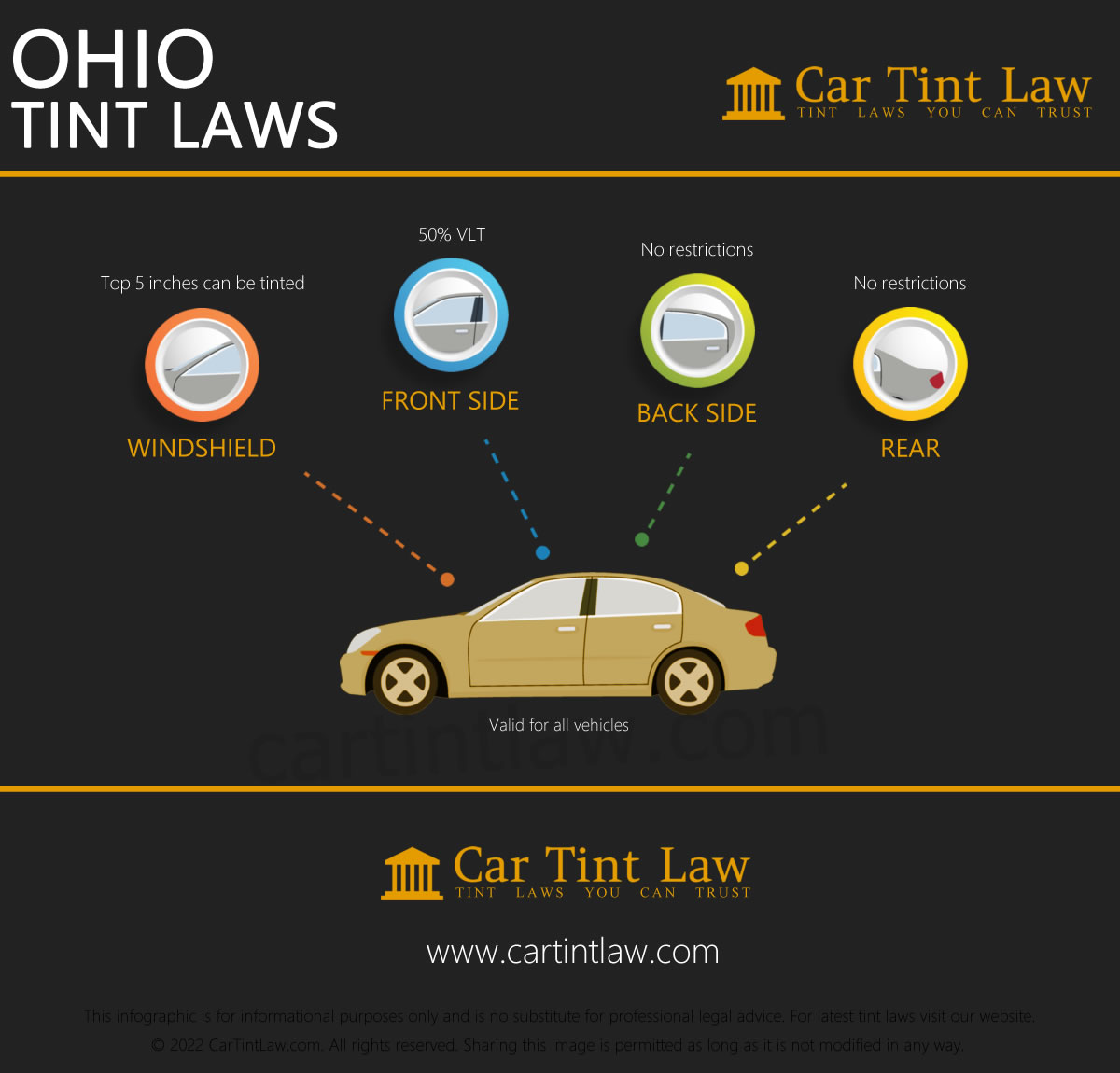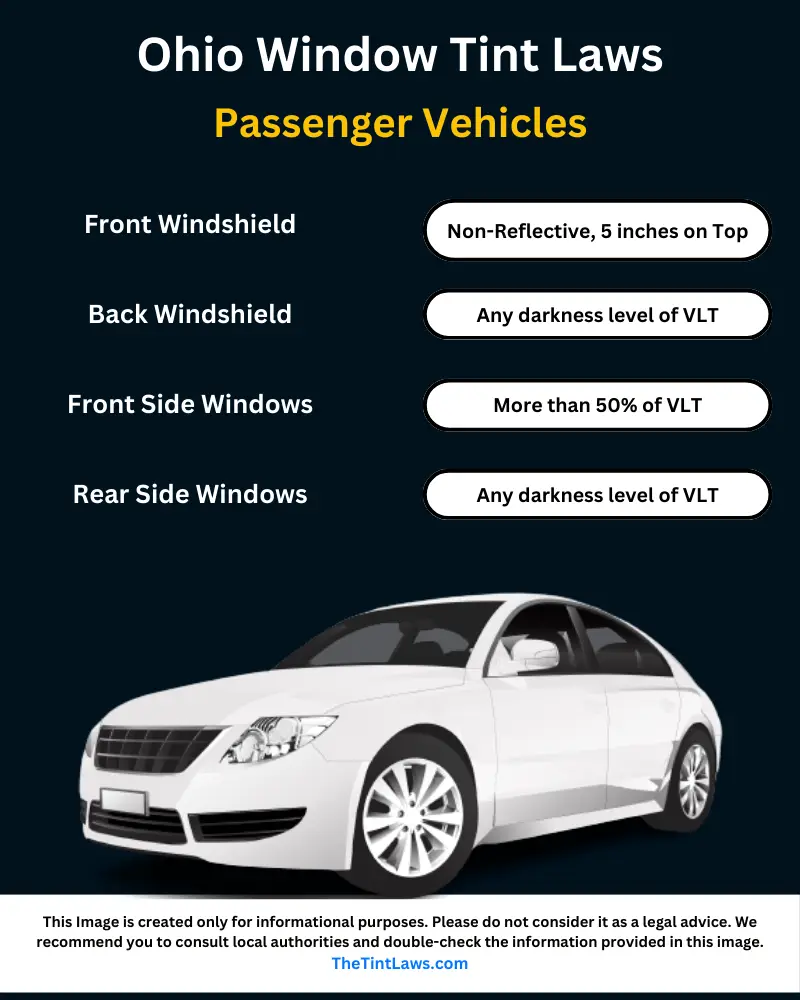Imagine driving through the scenic roads of Ohio, where the sun casts a dazzling glow over everything it touches. You squint against the brightness, wishing for a little more shade and privacy.
That’s where window tinting comes into play. But before you rush to get your car windows tinted, there’s something you need to know: Ohio Tint Law. This law governs how dark your car windows can be, ensuring safety and compliance on the road.
Understanding these regulations might seem daunting, but it doesn’t have to be. Whether you’re looking to upgrade your vehicle’s aesthetics or simply want a cooler interior, knowing the tint laws can save you from fines and headaches. Are you ready to dive into the specifics and make an informed decision? Let’s uncover everything you need to know about Ohio’s Tint Law and ensure your ride is both stylish and street-legal.

Credit: www.tintguy.com
Tint Law Basics
Understanding the fundamentals of Ohio’s tint laws can be crucial for both drivers and car enthusiasts. These laws dictate how dark or reflective your vehicle’s windows can be, ensuring safety and compliance on the road. Whether you’re considering adding a tint to your windows for privacy or style, it’s important to grasp the basics to avoid any legal hassles. Let’s dive into the key elements of window tinting and why these laws matter.
Definition Of Window Tinting
Window tinting involves applying a thin film to the inside of a vehicle’s windows. This film can vary in color and opacity, altering the amount of light that passes through. Tinting can enhance privacy, reduce glare, and even protect against UV rays. It’s a popular choice among drivers who want to personalize their vehicle while enjoying practical benefits.
But what exactly is legal in Ohio? Ohio’s tint laws specify the permissible Visible Light Transmission (VLT) percentage. This percentage determines how much light must pass through the windows. It’s essential to check these limits before you tint your windows to stay compliant.
Importance Of Tint Laws
Why should you care about tint laws? For starters, they play a significant role in road safety. Excessively dark tints can hinder your visibility and make it difficult for law enforcement to see inside your vehicle during traffic stops. Ensuring your tints adhere to legal standards helps maintain safe driving conditions.
Moreover, complying with tint laws can save you from hefty fines or penalties. Imagine being pulled over, only to realize your stylish window tints are illegal. It’s a costly mistake that can be easily avoided by understanding and following the regulations.
Are you confident your vehicle meets these standards? It’s worth double-checking, especially if you’re planning a cross-state road trip. Different states have varying tint laws, and what works in Ohio might not be legal elsewhere.
Current Regulations
Understanding Ohio’s tint law regulations is crucial for anyone considering tinting their vehicle windows. The rules are in place for safety, ensuring that drivers have sufficient visibility while also protecting law enforcement officers during traffic stops. If you’re planning to tint your windows, knowing what’s legally permissible in Ohio can save you both time and money.
Permitted Tint Levels
Ohio law specifies the level of tinting allowed on different windows of your vehicle. The front side windows must allow over 50% of light to pass through. This ensures that drivers maintain a clear view of the road, especially during night driving.
The rear side windows and the back window can be tinted more heavily, but they must still allow more than 70% of light to pass. Reflective tint is not allowed, maintaining fairness and safety on the road. Are you aware of these specific percentages? Knowing them can prevent legal issues and fines.
Vehicle Types And Tint Rules
Different rules apply to different types of vehicles. For passenger vehicles, the tint levels are stricter compared to multi-purpose vehicles. This is because passenger vehicles are more commonly used in a variety of driving situations.
Multi-purpose vehicles, like SUVs and vans, have more lenient tinting rules. They can have darker tints on the rear side windows and back window. However, all vehicles must adhere to the same rules for the windshield, where only a non-reflective tint is allowed on the top five inches.
Are you considering different options for your vehicle? Keep in mind that following these rules not only keeps you within the law but also ensures your safety and the safety of others on the road.
Exceptions And Special Cases
Ohio Tint Law includes exceptions and special cases for certain vehicles. Medical exemptions allow individuals with specific health conditions to apply for darker tints. These exceptions ensure safe driving while accommodating unique needs.
Navigating the rules and regulations of Ohio’s tint law can sometimes feel like walking a tightrope. While the standard laws are clear, it’s crucial to understand the exceptions and special cases that might apply to you. These exceptions could be the difference between a legal and an illegal tint on your vehicle. Have you ever wondered if your situation qualifies for an exception?Medical Exemptions
Ohio recognizes that some individuals have medical conditions requiring special consideration. If you have a medical condition that necessitates a darker tint, you might qualify for a medical exemption. Conditions like lupus or photosensitivity are examples that may warrant this exception. To apply, you’ll need a prescription or statement from a licensed physician or optometrist. Keep this documentation in your vehicle at all times. This can be your lifesaver during a traffic stop, saving you from potential fines or vehicle inspection failures. But remember, this exemption is specific to the individual and the vehicle. If you change cars, you’ll need to update the documentation. Have you checked if your medical condition qualifies under Ohio’s tint law? It might be worth a conversation with your doctor.Commercial Vehicles
Commercial vehicles often have different needs and uses compared to personal vehicles. Ohio law acknowledges this by allowing certain exceptions for these vehicles. If you drive a commercial vehicle, your tint requirements may vary based on the nature of your business. For instance, vehicles used for transporting goods or sensitive materials might need darker tints for protection. This not only safeguards the contents but also maintains privacy for your clients. However, make sure your vehicle is registered as a commercial vehicle to fall under this exception. Document the purpose of your tint with appropriate business licenses or documentation. This keeps you compliant and ready for any inquiries from law enforcement. Have you reviewed your commercial vehicle’s tint compliance lately? It’s a small step that can prevent major hassles down the road.Penalties For Non-compliance
Ohio’s tint law ensures safety and visibility on the road. Non-compliance leads to penalties, impacting drivers financially and legally. Understanding these penalties helps in avoiding costly mistakes.
Fines And Fees
Drivers face fines if they break Ohio’s tint law. The first offense may result in a $100 fine. Repeat offenders might pay more. Each violation adds to the total cost. Legal fees can also increase expenses. Paying fines promptly is essential. Ignoring fines can lead to bigger issues.
Impact On Vehicle Inspection
Tinted windows can affect vehicle inspections. Non-compliance might lead to inspection failure. Vehicles must meet state standards to pass. Failing an inspection results in extra costs. It requires fixing the tint to comply. This leads to spending more money and time. Ensuring compliance saves hassle during inspections.
Getting Your Tint Tested
Getting your car’s window tint tested in Ohio is crucial. It ensures compliance with state regulations and avoids potential fines. The state has specific requirements for the darkness and reflectiveness of window tints. Testing your tint helps you stay within legal limits. It also enhances your driving experience by ensuring safe visibility.
Locating Testing Centers
Finding a tint testing center in Ohio is easy. Many auto shops offer this service. Search online for testing centers near you. Check reviews and ratings before visiting. Some centers provide quick walk-in services. Others may need appointments. Always call ahead to confirm availability. Make sure they use state-approved testing equipment.
Understanding Test Results
Once tested, you will receive a report. This report shows the visible light transmission (VLT) percentage. Ohio law requires at least 50% VLT for front side windows. Rear windows and back side windows have different limits. Ensure your tint complies with these standards. Understanding the results helps avoid legal trouble. Keep the report for future reference. It’s proof of compliance if needed.

Credit: www.cartintlaw.com
Choosing Legal Tint Options
Choosing the right tint for your vehicle in Ohio involves understanding legal limits. Ohio Tint Law sets specific guidelines for how dark windows can be. These laws aim to ensure safety and visibility on the road. It’s crucial to pick a tint that complies with these regulations. This not only avoids fines but also maintains safe driving conditions. Knowing your options will help you make the best choice.
Recommended Tint Products
Several products on the market meet Ohio’s tint requirements. Consider tints with high UV protection and durability. Look for brands that offer warranty and quality assurance. Popular choices include ceramic and carbon-based tints. These provide excellent heat reduction and glare control. Always check product specifications for compliance with Ohio laws.
Professional Installation Tips
Hiring a professional ensures proper tint application. Experts know the legal limits and apply tints precisely. Professional installation avoids issues like bubbling and peeling. Choose installers with good reviews and certified expertise. Ask about their experience with Ohio Tint Law compliance. Proper installation enhances your car’s look and functionality.
Staying Updated On Laws
Understanding Ohio’s tint laws is crucial for drivers who want to avoid fines and ensure their vehicle’s compliance. Laws can change, and staying updated is a proactive step every driver should take. This section will guide you on how to keep abreast of legislative changes and where to find reliable resources.
Monitoring Legislative Changes
Legislation can shift due to new safety standards or public demand. As a driver in Ohio, it’s important to regularly check for updates on tint laws. One practical way is to monitor the Ohio Department of Public Safety’s announcements. They provide timely updates on any legal modifications.
Another effective method is subscribing to local news outlets. Many times, newspapers or online news portals will highlight changes in driving regulations, including tint laws. Consider signing up for email alerts from these sources to ensure you never miss crucial information.
Resources For Drivers
Reliable resources can make a significant difference in staying informed. The Ohio Bureau of Motor Vehicles website is a solid starting point. It offers comprehensive details on tint regulations and any alterations that may occur.
For those who prefer more interactive updates, online forums can be beneficial. Platforms where drivers share experiences and updates can offer practical insights. You might find firsthand accounts of how changes in tint laws affected other drivers, providing a more relatable perspective.
Consider joining a local car club or community. Members often share updates and personal stories about complying with new laws. Have you ever learned about a law change from a fellow club member? Such interactions can be eye-opening and keep you ahead of the curve.
Staying informed is not just about compliance; it’s about your safety and the safety of others. Are you prepared to act if the laws change tomorrow? Utilize these resources and strategies to ensure you’re always in the know.

Credit: thetintlaws.com
Frequently Asked Questions
What Is The Darkest Legal Tint In Ohio?
Ohio allows 50% VLT for front windows and 70% VLT for rear windows. Non-reflective tint is permitted on the windshield’s top 5 inches. Ensure compliance with regulations to avoid penalties. Always check for updates on tint laws as they can change.
Can You Have 35% Tint In Ohio?
Ohio allows 35% tint on rear windows but restricts front windows to 50%. Front windshield tinting is prohibited. Always check local laws for updates.
Is 20% Or 35% Tint Darker?
35% tint is lighter than 20% tint. A 20% tint allows less light to pass through, making it darker.
Can You Get Pulled Over For 5% Tint In Ohio?
Yes, you can get pulled over for 5% tint in Ohio. Ohio law requires front side windows to allow more than 50% light. If your vehicle’s tint is too dark, it may lead to a traffic stop and potential fines.
Always ensure compliance with local tint regulations.
Conclusion
Understanding Ohio’s tint law is important for every driver. It keeps you safe. Following these rules prevents fines and legal trouble. Safety matters, both for you and others on the road. Legal tinting ensures clear visibility. Day and night. Check your car’s tint level.
Make adjustments if needed. Stay informed about changes in the law. This helps maintain compliance. Remember, these laws are for your protection. Keep your vehicle in line with state regulations. Drive safely with legal tint. Your peace of mind matters.
Always.
